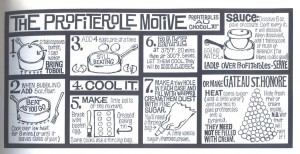A few weeks ago Matt Kirschenbaum spoke about Len Deighton, the British spy novelist whose Bomber (1970) is considered the first novel written on a word processor. Len Deighton was also a fairly prolific cookbook author. But Deighton didn’t write his cookbooks on a word processor. In fact, he did quite the opposite: he illustrated most of his recipes in comic strip form. The recipes appeared in a regular column in the London Observer as “cookstrips” and then in several cookbooks throughout the sixties and seventies. I’m a huge fan of his cookbooks and thought I’d share some of his strips here. Deighton’s cookbooks also demonstrate that while he might’ve embraced technology in some areas of his work, he was open to many forms of literacy and communication.
Category Archives: Uncategorized
Thing Theory and Interactivity
It is striking that discussions of theory in DH seem primarily focused on how DH projects themselves provide theory rather than actually theorizing about the nature of DH as an academic discipline. The latter ostensibly belongs more appropriately to a discussion on defining DH (as we have discussed in week 2), but I find it productive and relevant to discuss here. Looking first at what Ramsay and Rockwell refer to as “thing theory” then noting the importance of interactivity in digital scholarship, I will attempt to broadly approach these two issues—i.e., locating theory in DH and literally defining a theory of DH—to substantiate DH as a theoretical undertaking but more importantly to illustrate how DH is unique from traditional humanities.
Regarding the hack vs. yack debate, it seems clear that even the strongest proponents of methodology over theory would agree that there is no strict dichotomy between the two. As Natalia Cecire notes, “the two are not antithetical” (56). In fact, hack and yack share essential qualities, namely the overall goal of humanistic inquiry. The only apparent differences involve the tools and media utilized. But throughout history humans have used a variety of tools and media to externalize thought (from Paleolithic cave paintings to film and new media). Simply put, humanities scholarship has long suffered from the tyranny of oral and written discourse as its primary media. DH utilizes digital tools as its media to externalize thought and humanistic inquiry. The digital product itself possesses (or should possess) the essential qualities of a written piece of scholarship, i.e., theory (notably, theory with a lower case “t”).
Ramsay and Rockwell refer to this as thing theory: “Prototypes are theories, which is to say they already contain or somehow embody that type of discourse that is most valued—namely, the theoretical” (3), and later more poignantly claim, “To ask whether coding is a scholarly act is like asking whether writing is a scholarly act” (8). I would perhaps add that coding itself is a form of writing, just as, for instance, filmmaking or other media creation are forms of writing, insofar as a communicable textual entity is created. As Drucker notes, such forms of scholarship involve “an analysis of ways representational systems produce a spoken subject” (8).
Can a film not act as a form of scholarship? Interestingly, tenure-track faculty in film production departments (though not necessarily a humanities discipline) are assessed purely on their body of film work. And it seems equally valid for a traditional humanist to produce a provocative film in lieu of a formal essay. Additionally, an inherent rule in filmmaking (though often broken) involves concealing the process (the tools). Regarding digital scholarship, Patrick Murray-John notes, “A good user interface is designed specifically so that you don’t have to deal with the inner workings of the application” (76). This is becoming a bit of a digression, but I would at least like to pose the question: is this an important rule for DH?
Equally striking, however, is Gary Hall’s take in “There are No Digital Humanities.” Hall questions the computational turn in humanities as a movement, stressing the notion that it appears to be a reverse of Lyotard’s Postmodern Condition, allowing science and quantitative information to dominate the humanities. This is an important point that deserves deeper investigation, particularly as DH continually evolves.
Ben Schmidt’s thesis is particularly useful here: “The answer, I am convinced, is that we should have prior beliefs about the ways the world is structured, and only ever use digital methods to try to create works which let us watch those structures in operation” (61). The individual subject, the human, is key in interpreting even the most empirical humanistic inquiry. Furthermore, DH fundamentally advocates open-access and, more importantly, interactivity. The ability of the user (scholar or non-scholar) to experience a DH work and interpolate his/her experiences and thoughts seems to allow DH to evade a reversal of postmodernism. Whether via data visualization, topic models, or simply blogs and open-access texts, which allow peer review/critique and interactivity with the text, the foundation of DH as a discipline appears firmly rooted in subjective humanistic inquiry in a manner that is unique and potentially more effective than traditional scholarship.
In this sense, DH can and should innately contain both theory (generally speaking) as well as a theory of itself, i.e., promoting subjective interactivity with relatively objective knowledge.
NYPL Labs-Turning Physical Data into Digital Knowledge
Hello,
Last month I attended a Hacks/Hackers http://hackshackers.com event that the NYPL hosted. Here is a blog post from the NYPL Labs team discussing what was covered http://hackshackers.com/blog/2013/09/16/nypl-labs-turns-physical-data-digital-knowledge-hhnyc/ and there is a link to the slides that were used during the presentation: https://dl.dropboxusercontent.com/u/5949624/NYPL-Labs-9-10-13-HacksHackers.pdf
When we were asked to define Digital Humanities a few classes ago, my definition was a clunky explanation about accessibility to information. I think the projects that the NYPL Labs team are working on exemplify what I understand the digital humanities to be. Also, I think it’s revolutionizing the access to information that public libraries can provide…which is very exciting.
-Melanie Locay
Kirschenbaum’s, “The Book-Writing Machine”
Warning: tangents ahead….
What I found interesting about Kirschenbaum”s article “The Book-Writing Machine” (aside from the window being removed and the weight of the computer) was the absurd amount of coincidences that overlapped with Len Deighton’s novel Bomber and the MTST. It seems like Kismet when Len Deighton was told about IBM’s MTST and that he used it to write his novel, Bomber, . Was it happenstance that his assistant, Ellenor Handley would be complaining to a typewriter technician, further that the technician was aware of the latest “machine” that could possible aid her in writing or rather rewriting, makes you wonder about what we lose when we rely solely on computer mediated communication, here we see how ideas were shared face-to-face, a solution was produced. Social media/collaboration back in the 70’s.
I read more on MTST, apparently Jim Henson was requested by IBM to produce a PR film “Paper Explosion” extolling the benefits of MTST: ( and now completely off track…the man at the end film looks like the inspiration for Henson’s muppets Statler and Waldorf (stage left balcony box)
and that Deighton was the first novel to be written via word processed….
I did a quick search and found an article from 2007 (ancient) that states “In Japan, half of the top ten selling works of fiction in the first six months of 2007 were composed on mobile phones.”
any clues as to what could be next…..
Dialogues on Feminism and Technology
The experimental online class Dialogues on Feminism and Technology led by Anne Balsamo and Alexandra Juhasz has begun posting weekly video conversations. Sixteen colleges are participating, including CUNY’s Graduate Center and Macaulay Honors College, as well as thousands of learners outside of formal educational settings. The class is intended to be a model for open access pedagogy in a collaborative environment, in contrast to MOOC-style learning. For those without institutional logins, there are suggested readings to accompany the class.
As an example of the ideas about women and technology in popular culture that they are seeking to counter, class organizers point to a June 2012, New York Times article about Silicon Valley which opened with “Men invented the Internet.” Partly to address that type of thinking, students will participate in Storming Wikipedia, an exercise in writing and editing to include women and feminist scholarship in Wikipedia. HASTAC has a wiki page about the Wikistorming that took place earlier this year.
privacy and recording lectures
Like Sarah, I take for granted that public universities and classes promote information sharing. The articles and cases I’ve read are very blurry–according to NY Recording law, recording in a public university may fall under the category of recording a public meeting…which means no consent is required.
This article raised some great points, focused on Livescribe recordings.
Here is the direct link to NY’s recording laws.
DefiningDH
Initial:
The digital humanities is an academic community, its members united by interest in (and use of) digital tools to 1) redefine their research and analytical practices and/or 2) cultivate new forms of academic collaboration and dialogue. Its sustainability, emergent goals, and politics are reactive to wider industry developments and economic forces.
Secondary:
The Digital Humanities is an emerging discipline within the field of information science.
Reflection:
I have found it exciting to follow DH issues and studies that are continually emerging in networked spaces, shaped by a dynamic community that seems to self-identify and develop new ideas at a rapid pace. Discovering the latest questions and critique within the discipline itself has piqued my interest in understanding the trajectories of those discussions. But while I think the world of DH-introspection enriches the discipline and fosters its growth, it at times seems a veil for the natural growth and potential for the field. Given the rapid adoption of digital tools, computational frameworks, and data mining in most areas of contemporary scholarship (and industry, government, etc.), I’m interested in why proving the value and relevance of digital methods within the humanities is a different process than it is in other realms.
As a result, I’d like to further explore how DH, as a practice, resonates with larger trends in digital practices, and how deeply interdisciplinary projects manifest the value of DH methodologies — perhaps in ways that transcend semantic qualms and curb the agency of an Analog vs. Digital duality.
But if DH is contingent on dualism (at least for the time being), perhaps alternative definitions of DH arise when one of its basic value propositions (that digital tools will deliver new value to the humanities) is inverted. For instance, there are computer and social scientists interested in questions of language, interpretation, expression, philosophy….so how can longstanding lines of inquiry in the humanities bring new dimensionality to the methods that those social and computational scientists use? I am hoping to come to a 3rd definition of DH that fortifies the idea (in practice as well as theory) that the digital needs the humanities just as the humanities need the digital.
Remediating the Avant-Garde
Just wanted to let everyone know about a two-day program at Princeton University in October on Avant-Garde magazines and digital archives. Looks to be a fascinating discussion on how to represent these periodicals in a digital landscape — and the program is free.
More info here: http://bluemountain.princeton.edu/conference/index.html
The Science/Humanities Gap
A few of the DefiningDH blogs have touched on the disparity between/problem of digital research methods in the sciences and humanities, and how humanists can use technology in their work. Here is a recent NY Times article I stumbled across on this:
http://opinionator.blogs.nytimes.com/2013/09/18/sciences-humanities-gap/?_r=0
Without mentioning Digital Humanities per se, the author (who is responding to another interesting article about how humanists MUST embrace the sciences) believes humanists are well aware of this gap:
Pinker notes the antiscientific tendencies of what he calls “the disaster of postmodernism, with its defiant obscurantism, dogmatic relativism, and suffocating political correctness.” But literary studies, the bastion of these tendencies, have long been moving in other directions, including a strong trend toward applying scientific ideas and methods. There is, for example, the evolutionary and neurological study of literature and, most recently, the use of computer data-mining.
There is, then good reason to think that the greater problem is scientists’ failure to attend to what’s going on in the humanities.
In the readings this week, Lev Manovich poses a similar problem in relation to data access and interpretation:
I have no doubt that eventually we will see many more humanities and social science researchers who will be equally as good at implementing the latest data analysis algorithms themselves, without relying on computer scientists, as they are at formulating abstract theoretical arguments. However, this requires a big change in how students in humanities are being educated.
Manovich leaves this question open-ended, and it’s a big one. Both authors seem to be bothered by disciplinary narrowness and a lack of cooperation across disciplines.
I don’t know about anyone else, but part of the reason I was attracted to Digital Humanities was the fact that many of my research and teaching questions can’t be answered by taking more Literature classes.
DH Definitions: Before, after and now.
1. At the start of class: Digital Humanities could be defined as the broad and fluctuating assortment of an amalgamation of all facets of the established humanities which are connected and/or mediated by technology.
2. End of Class: Digital Humanities could be defined as the radical shift in the traditional humanities that integrates the entire scope of technological interaction which may yield a mixture of collaborative and emerging work.
3. After the discussion in class I believe there is an essential aspect to the digital humanities versus the traditional humanities and that is the coined word “eversion”. All we know to be true within the idea of acquired knowledge has altered and will continue to change. The ability to access, collaborate and build momentum is the central shift. Since technology is allowing for the outsider to enter into a new relationship between the traditional humanities and the digital humanities, this new relationship has endless possibilities in virtually (pun intended) all aspects of knowledge.




